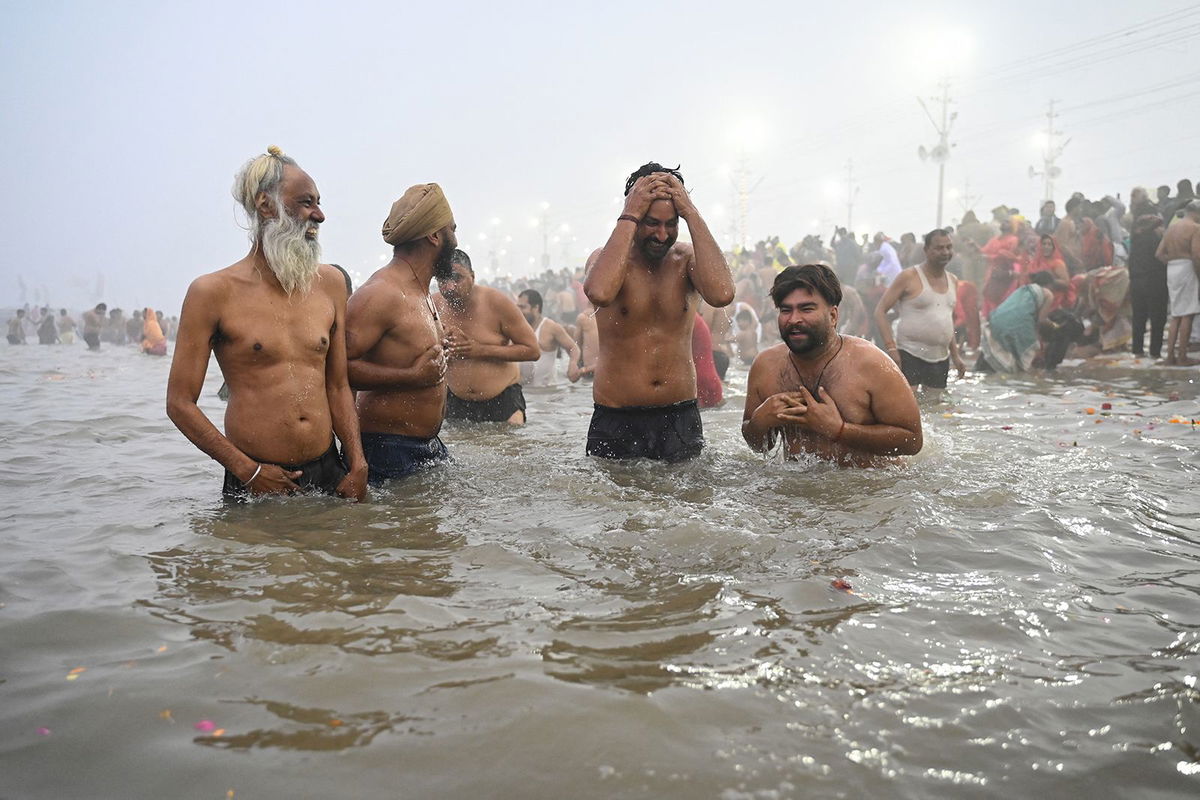One of the world’s greatest religious spectacles is underway and the numbers are staggering

Hindu pilgrims take a dip in the sacred waters of Sangam
By Aishwarya S Iyer, CNN
New Delhi (CNN) — Millions of Hindu devotees are bathing in sacred waters as the world’s biggest religious gathering begins in India’s northern state of Uttar Pradesh.
Over the next six weeks, a staggering 400 million people are expected to attend the Maha Kumbh Mela, or the festival of the Sacred Pitcher, on the riverbanks in the city of Prayagraj.
Every 12 years the festival carries the prefix “Maha,” which means great, as it’s the largest gathering of the Kumbh Mela that’s held every three years in one of four cities.
In Prayagraj, followers will bathe in the Triveni Sangam, the confluence of three holy rivers – the Ganga, Yamuna and the mythical Saraswati – to purify their sins and take another step closer to “spiritual liberation.”
The Kumbh draws upon Hindu mythology and the legend of demons and gods fighting over a pitcher containing the elixir of immortality. During the fight, four drops from the pitcher fell on Earth, in Prayagraj, Nashik, Haridwar and Ujjain, which host the festival in rotation.
The gathering is particularly well-known for attracting large crowds of Hindu holy men, known as sadhus, who travel from across the country. Sadhus are ascetics who have renounced worldly goods and life and are famous for their dreadlocks, ash covered bodies as well as their bright – and at times minimal – clothing.
On Tuesday morning, scores of sparsely clad sadhus bathed in the waters as part of a key moment at the start of the festival. Uttar Pradesh’s Chief Minister Yogi Adityanath said late Tuesday that more than 35 million people had “earned the holy benefit of bathing in the uninterrupted and clean Triveni,” or the confluence of the rivers, over the course of the day.
Indian Prime Minister and Bharatiya Janata Party (BJP) leader Narendra Modi has invited people from all over the world to attend the festival, recognized by UNESCO in 2017 as an “intangible cultural heritage of humanity.”
Authorities are promoting the event not just as a religious gathering but a cultural spectacle that in the past has attracted both Bollywood and Hollywood stars.
Formerly known as Allahabad, Prayagraj was renamed by Adityanath in 2018, a decision that was said to recognize the city’s identity as a spiritual destination for Hindu pilgrims.
Shedding the name Allahabad, given to the city by Mughal emperor Akbar, was a symbolic move in keeping with Modi’s ambitions to transform India from a secular, pluralistic state into a nation of and for the Hindu faith.
This year’s festival has taken years of planning and millions of dollars to build facilities for the influx of visitors to Prayagraj, a city normally home to 6 million people.
Around 160,000 tents, 150,000 toilets and a 776-mile (1,249-kilometer) drinking water pipeline have been installed at a temporary tent city covering 4,000 hectares, roughly the size of 7,500 football fields.
In 2013, dozens of people were killed and injured in a crowd crush at a railway station as pilgrims gathered in the city. Such deadly incidents at religious gatherings in India are not uncommon, often highlighting a lack of adequate crowd control and safety measures.
This year, officials say extra safety measures have been put in place in Prayagraj to protect visitors, including a security ring with checkpoints around the city staffed by more than 1,000 police officers.
Over 2,700 security cameras powered by artificial intelligence will be positioned around the city, monitored by hundreds of experts at key locations, according to the central government.
Aerial drones will provide surveillance from above and for the first time, underwater drones capable of diving up to 100 meters will be activated to provide round-the-clock cover, the government added.
Vast numbers of pilgrims are expected to travel to the region by train, so authorities have added 3,000 special trains and 13,100 train services.
Fourteen new flyovers and underpasses, 11 new road corridors, 7,000 buses, 550 shuttle buses, seven new bus stops, and 30 pontoon bridges have also been added to improve connectivity, according to the Uttar Pradesh state government.
The festival ends on February 26.
The-CNN-Wire
™ & © 2025 Cable News Network, Inc., a Warner Bros. Discovery Company. All rights reserved.